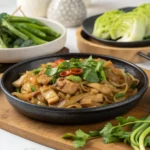Let’s be honest — most of us fall in love with Pad See Ew from the first smoky bite at a late-night Thai spot. Thick, glossy rice noodles tangled in a sweet-salty soy glaze, a touch of char that whispers “wok hei,” and that comforting chew you can’t fake with spaghetti. It feels like a dish that must be impossible to pull off at home. But here’s the thing: it’s not. You just need to know what truly matters.
Pad See Ew which literally means “ stir- fried soy sauce polls ” — is Thailand’s hearty and bravely seasoned take on classic comfort food. It’s not flashy like Pad Thai. It’s earthier, deeper, unapologetically umami. The kind of dish where caramelized edges and simplicity are the secret sauce.
This guide isn’t just a recipe. It’s a mini crash course in how to hack restaurant-level flavor in your kitchen, no wok burner required. We’ll break down each element — from finding the right noodles (or faking it smartly) to building that signature sauce with pantry-friendly hacks.
By the end, you wo n’t just know how to make Pad See Ew. You’ll understand it — and that makes all the difference.
What is Pad See Ew? The Bold, Chewy Icon of Thai Street Food
At first glance, Pad See Ew looks deceptively simple: wide rice noodles, dark soy sauce, a few greens, and protein. But underneath that minimalism lies a dish with centuries of influence and a character all its own. The name “Pad See Ew” literally means “stir-fried with soy sauce” — and that’s your first clue: soy is the soul here, not spice, not sweetness.
A Dish Born from Chinese Roots, Perfected in Thai Hands
Pad See Ew has deep roots in Chinese cuisine — specifically chow fun — but it evolved through Thai street vendors who added their own rhythm to the wok. The key difference? That signature smoky char. Thai cooks intentionally press the noodles against high heat to give them slightly crispy, caramelized bits. It’s not burnt — it’s flavor. And formerly you taste it, you’ll chase that texture ever.
How It Stands Apart
You might wonder how it compares to Pad Thai or Drunken Noodles. Here’s a quick flavor map:
- Pad Thai is tangy and peanut-y.
- Crapulous polls( Pad Kee Mao) are racy and garlicky.
- Pad See Ew is savory, slightly sweet, and all about that hoarse depth.
Pad See Ew is the introvert in the trio — subtle but rich, grounded, and often underestimated.
Why Is Pad See Ew So Popular?
Simple answer: it’s ridiculously satisfying. The chewy noodles, the contrast of tender meat with crunchy greens, and the unmistakable dark soy umami make it a full sensory experience. It’s also incredibly adaptable — swap the protein, tweak the greens, go veggie — and it still works.
FAQ – Is Pad See Ew spicy
Not by default. Unlike many Thai dishes, Pad See Ew is not inherently spicy. That said, it pairs beautifully with a side of pickled chilies or a dash of chili flakes if you want a heat boost. Think of it as a blank canvas for spice lovers — or a mellow alternative if you’re not into heat.
Essential Ingredients & Substitutions for Pad See Ew
You don’t need a trip to Bangkok or a specialty store to pull this off. But you do need to understand which ingredients matter — and which ones you can cheat on without losing the soul of the dish. Let’s break it down.
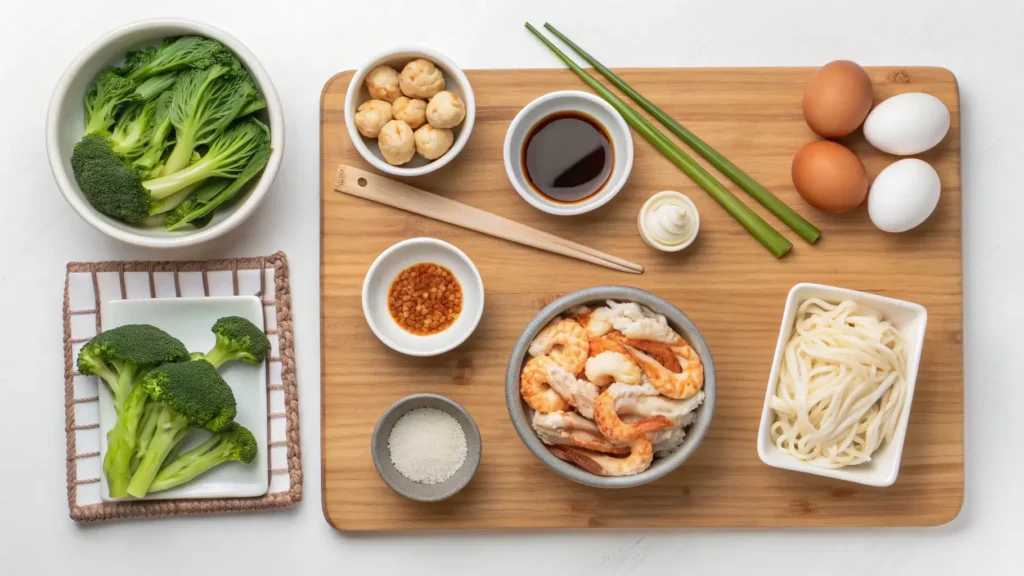
The Noodles — Wide, Fresh, and Chewy
Traditional choice: Fresh wide rice noodles (called Sen Yai) are the heart of Pad See Ew. They’re soft, leathery, and absorb flavor like a dream.
Reality check: Not everyone lives near an Asian grocer. If you can’t find fresh noodles:
- Use dried wide rice noodles like those for pho or pad thai (soak until pliable).
- In a pinch? Cut up cooked lasagna sheets or use udon noodles — not authentic, but they mimic the bounce.
Pro tip: Whatever noodle you use, don’t over-stir. Breakage = sadness.
The Protein — Chicken, Tofu, or What You’ve Got
Classic Pad See Ew uses thinly sliced pork or funk. But this dish is flexible:
- Chicken or beef: Thinly sliced and marinated for tenderness.
- Tofu: Use firm tofu, pan-fried until golden for a crispy edge.
- Shrimp: Works beautifully but cooks fast — add it last.
Marinate your protein (even briefly) in soy sauce and cornstarch for that tender, slippery texture Thai dishes are famous for.
The Veg — Chinese Broccoli and Beyond
Traditional Pad See Ew stars Gai Lan( Chinese broccoli), which has thick stems and slightly bitter leaves. Can’t find it? Here’s your cheat sheet:
- Broccolini or baby broccoli
- Kale (Tuscan works best)
- Spinach or bok choy for a softer bite
You want a green that holds its texture under high heat and adds contrast to the chewy noodles.
The Sauce — A cotillion of Nights and Lights
The sauce is where things get emotional. It’s a mix of:
- Dark soy sauce (the smoky, caramel-tasting base)
- Light soy sauce (adds salinity)
- Oyster sauce (rounds it out with umami)
- White ginger or rice ginger( voluntary, for a little lift)
- Sugar( just a pinch to balance the swab)
Dietary swaps:
- Gluten-free? Use tamari or gluten-free soy sauces.
- Vegan? Sub oyster sauce with mushroom stir- shindig sauce or hoisin
The exact ratio can vary — we’ll get to the magic combo in the next section.
FAQ – Can I make Pad See Ew without a wok?
Yes, absolutely. A large nonstick skillet or cast iron pan works fine. The key is high heat and not overcrowding the pan — stir-fry in batches if needed. You won’t get true wok hei, but you can still get that tasty caramelization.
Crafting the Perfect Pad See Ew Sauce: Salty, Sweet, and Smoky
This is the moment that separates “decent homemade stir-fry” from actual Pad See Ew. The sauce is deceptively simple, but each ingredient plays a critical role. You’re not just dumping soy sauce on noodles — you’re building flavor that hits in layers.
The Core Five: Sauce Ingredients That Matter
Here’s the base formula (you can tweak it to taste):
- 1 ½ tbsp dark soy sauce – This is the soul. It’s thicker, sweeter, and adds that inky, rich color.
- 1 tbsp light soy sauce – Brings the salt and a sharp edge.
- 1 tbsp oyster sauce – Adds body and a round umami finish.
- ½ tsp white sugar – Just enough to mellow out the saltiness.
- 1–2 tsp vinegar (optional) – Rice or white vinegar gives brightness, but leave it out if you want a darker, more traditional profile.
Mix this in a small bowl before cooking — trust me, you don’t want to be fumbling with bottles mid-sizzle.
Want More Kick or Depth? Try These Tweaks
- Add fish sauce (½ tsp): For those who want more funk and salt.
- Touch of sesame oil: Not traditional, but adds a nutty edge.
- Crushed garlic or chili paste: If you want heat or zing — not classic, but fun.
Important: This sauce is strong by design. The noodles are bland — they need this level of intensity
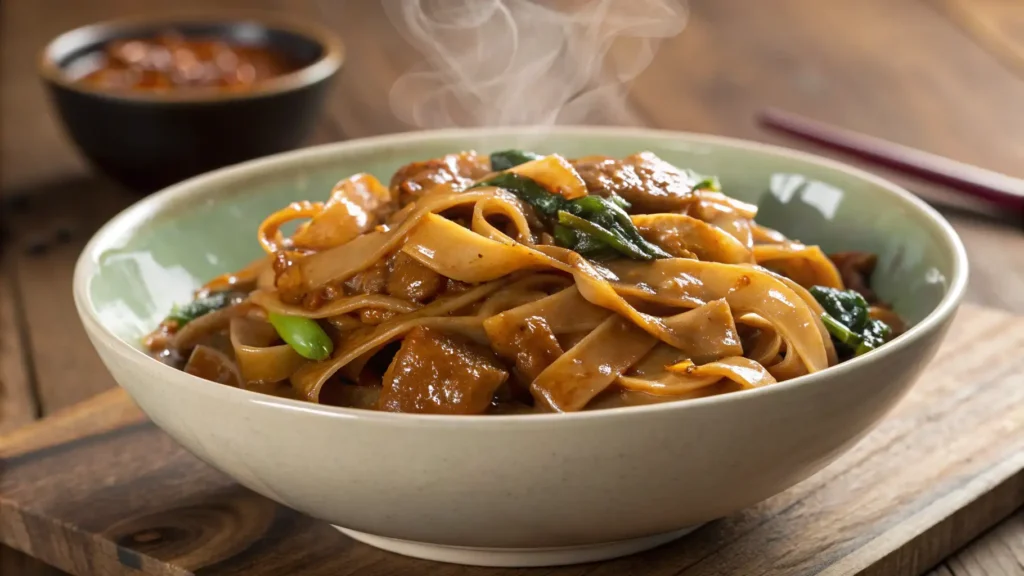
Sauce Ratios for One Dish (2 servings)
Still, then’s a dependable blend for 200g of polls
- 1.5 tbsp dark soy
- 1 tbsp light soy
- 1 tbsp oyster sauce
- ½ tsp sugar
- (Optional) 1 tsp vinegar
Scale up or down depending on your taste, but always err on the side of slightly too bold — the noodles will dilute it.
FAQ – Can I make this sauce ahead of time?
Yes, and you should. You can mix a batch and store it in a jar in the fridge for up to 2 weeks. It makes midweek stir-fries so much faster — and more consistent.
Step-by-Step Cooking Instructions for Pad See Ew
This is where the magic happens — but don’t worry, it’s not a culinary obstacle course. You just need high heat, fast hands, and the confidence to let things char a little. Here’s how to bring it all together without stress.
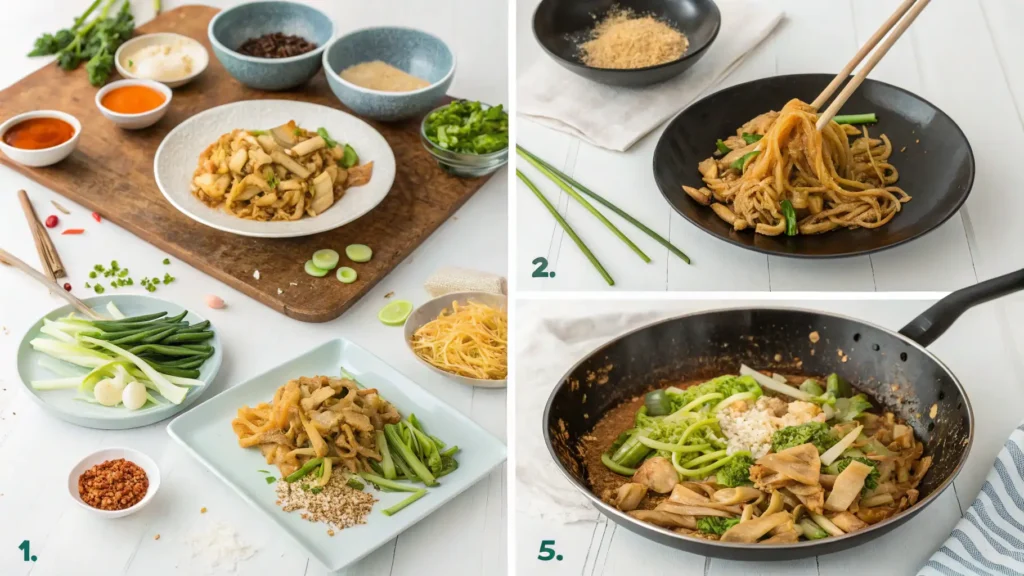
Step 1 – Prep Everything First (Seriously)
Pad See Ew moves presto, and once the visage is hot, there’s no time for slicing or measuring. Get this ready ahead:
- Noodles: If using dried, soak until soft, then drain. If using fresh, gently separate strands.
- Protein: Slice thin and marinate (just a splash of soy + cornstarch).
- Veggies: Wash and cut Gai Lan into 2-inch pieces (separate stalks from leaves).
- Sauce: Mix your dark soy, light soy, oyster sauce, sugar, and vinegar in a small bowl.
Keep everything within arm’s reach — this is not the time to be rummaging.
Step 2 – Cook the Protein
- Heat 1 tbsp oil painting in a large skillet or wok over high heat.
- Add protein (chicken, beef, tofu) in a single layer — don’t crowd it.
- Sear until browned, then flip and cook through. Remove and set aside.
Why separate? Because protein needs time to brown, and overcrowding turns stir-fry into steam-fry.
Step 3 – Char the Noodles (This Is the Secret)
- Add another 1 tbsp oil painting to the visage.
- Toss in the drained noodles. Don’t stir too much — let them sit for 30–45 seconds to caramelize.
- Flip or stir gently, then push to the side.
You’re after those brown, slightly crispy spots that scream wok hei. This is where flavor happens.
Step 4 – Add Veggies and Combine
- Throw in your veggies (start with the stalks).
- Stir-fry for about 1 minute, then add the leaves.
- Return the protein to the pan.
- Pour the sauce evenly over everything.
Toss quickly — you want everything coated and glossy but not soggy. High heat is your friend here.
Step 5 – Taste and Adjust
Before you serve, taste a noodle. Need more salt? A splash of soy. Too salty? Add a squeeze of lime or touch of sugar. Want more heat? Chili flakes or pickled chilies on the side.
Serve immediately — Pad See Ew doesn’t wait.
FAQ – Can I reheat Pad See Ew?
Yes, but gently. Microwave on medium with a damp paper towel to avoid drying out the noodles. Or reheat in a pan with a splash of water. Just don’t overcook — rice noodles get gummy fast.
Tips for Success: How to Nail Pad See Ew Every Time
Pad See Ew is n’t hard but it’s precise. And once you get these little tricks right, your homemade version will outshine most takeout spots. No wok required, just some intentional choices.
Let the polls Sit — Do n’t Stir Too Soon
The #1 rookie mistake? Stirring too early. To get that crave-worthy char (a.k.a. the Thai street food signature), you need to let the noodles make contact with the pan. That golden-brown caramelization takes about 30–45 seconds per side — and it’s worth the wait.
Resist the urge. Flip once. Flip again. Done.
Don’t Crowd the Pan
Too many ingredients = steam, not stir-fry. Work in batches if needed. That’s how you keep the noodles chewy, not soggy. If you’ve ever made “noodle mush,” this is probably why.
- Use the largest pan you own.
- Keep heat on high.
- Give everything space to breathe.
Protein Goes First (But Not Too Early)
Start by searing your meat or tofu, then remove it before cooking the noodles. Why? Because overcooked protein is dry and rubbery — and it blocks noodles from hitting the pan. Let it come back at the end when it can finish cooking in the sauce.
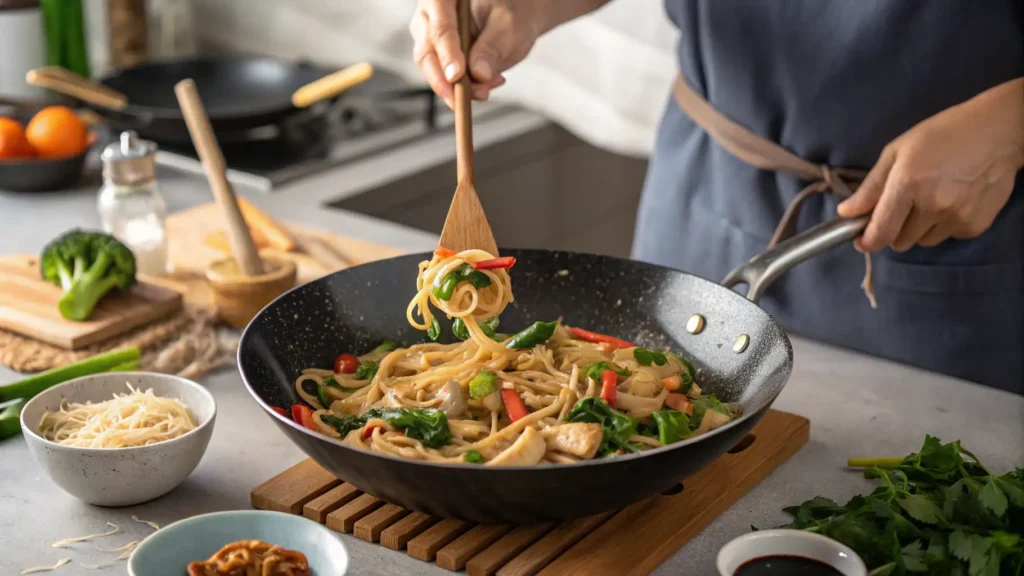
Adjust Flavor Last-Minute
Taste before serving. If it’s too salty, try:
- A squeeze of lime
- A pinch more sugar
- A splash of water
If it’s too bland, hit it with a little more soy sauce or a few chili flakes. Don’t assume your first mix is perfect — the wok teaches you in real time.
FAQ – Why are my noodles breaking apart?
Likely reason: Over-stirring or boiling them too long. Rice noodles are fragile, especially when wet. Use tongs or a gentle toss motion. And always drain well — wet noodles steam instead of frying.
Variations & Dietary Adaptations: Make Pad See Ew Your Own
The beauty of Pad See Ew? It’s more flexible than it looks. While the classic version hits a perfect balance of salty-sweet and charred-soft, there’s plenty of room to adapt — whether you’re going plant-based, gluten-free, or just clearing out the fridge.
H3: Vegetarian & Vegan Options
Pad See Ew goes meatless beautifully. Here’s how to do it without sacrificing depth:
- Protein: Swap meat for crispy tofu, tempeh, or even seared mushrooms (shiitake or oyster = best flavor).
- Oyster Sauce Replacement: Use vegetarian mushroom sauce or hoisin with a dash of soy.
- Watch the Noodles: Some fresh rice noodles are made with egg — check the label if strictly vegan.
Want that elusive umami hit? Add a splash of miso broth, mushroom powder, or a tiny pinch of MSG (yes, really — it’s safe, and Thai chefs use it).
Gluten-Free Adaptations
Pad See Ew can be totally gluten-free with a few swaps:
- Noodles: Rice noodles are naturally GF, but double-check packaging.
- Soy Sauces: Replace with tamari (for light soy) and GF dark soy or a mix of molasses + tamari.
- Oyster Sauce: Use a certified GF version or mushroom sauce.
Pro tip: Don’t skip the sauce just because of one ingredient — almost everything has a solid gluten-free version now.
Other Fun Twists
- Add a fried egg on top — it’s not traditional, but the richness plays great with the salty sauce.
- Make it spicy with Thai chili flakes or fresh bird’s eye chili.
- Use different greens like napa cabbage, spinach, or choy sum.
- Try shrimp for a sweeter, seafood-forward variation.
You’re not betraying tradition — Thai street food is built on adaptation.
FAQ – Can I use spaghetti or other Western noodles?qz
While Pad See Ew is typically served plain, you can elevate it with subtle additions:
- Thai chili vinegar (Prik Nam Som): Spicy, sour, and bright — perfect for cutting through the richness.
- Chili flakes or chili oil: For heat lovers.
- Lime wedges: Add sharp contrast to the soy-heavy base.
- Fried garlic or shallots: Crunch and fragrance in one bite.
Set these out DIY-style so people can build their perfect plate.
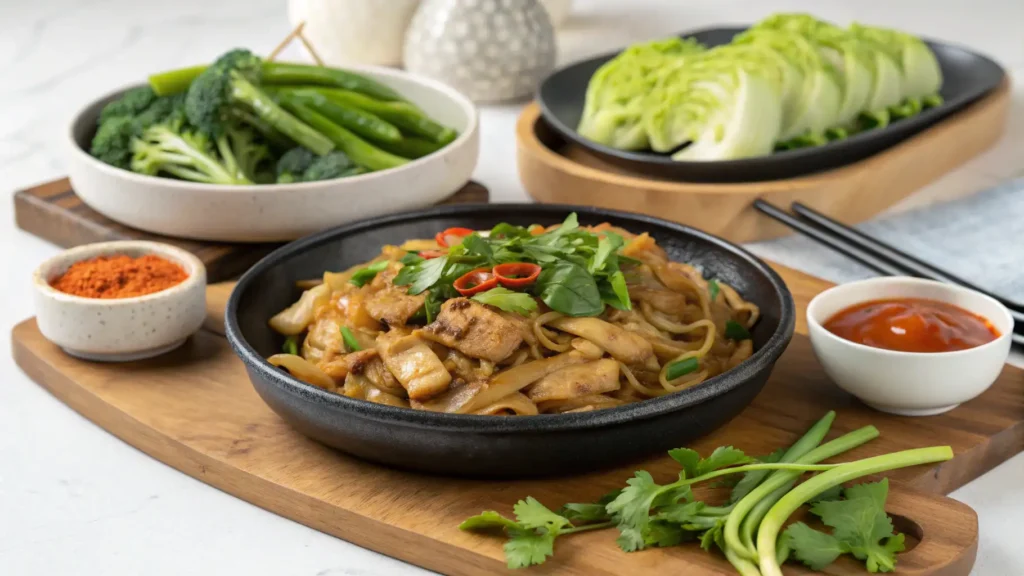
What to Serve With Pad See Ew
Want to round out the meal? Try these pairings:
- Thai cucumber salad (Som Tum): Fresh, tangy, and refreshing.
- Tom Yum soup: Spicy-sour broth to balance the savory noodles.
- Thai iced tea or lemongrass drink: Sweet and cooling, classic contrast.
If you’re going low-effort, even a side of sliced cucumbers with a vinegar drizzle works.
Leftovers? Here’s How to Store and Reheat
- Store in an watertight vessel for over to 3 days.
- Reheat in a nonstick pan with a splash of water or broth to loosen the noodles.
- Microwave in 30-second bursts, covered with a damp towel.
Pad See Ew does dry out a bit overnight, but a touch of extra sauce or oil brings it back to life.
FAQ – Can I meal prep Pad See Ew?
Sort of. Cook the components ahead (protein, noodles, sauce), and store them separately. When ready to eat, combine and reheat in a pan for that just-cooked texture. Fully assembled leftovers tend to get mushy if reheated too often.
Conclusion
Maybe you came here wondering if Pad See Ew was one of those dishes best left to restaurant woks and late-night cravings. Hopefully now, you’re seeing it differently. With a handful of ingredients, a hot pan, and a little know-how, you can pull off flavors that feel like they came straight from a Bangkok alley — smoky, salty, chewy, and just complex enough to impress yourself.
But more than that? This recipe invites you to play. Switch up the greens. Try a new protein. Dial the sauce to your taste. That’s the soul of Thai cooking — bold yet flexible, rooted in tradition but built for adaptation.
So Coming time the pining hits, skip the delivery app. Grab a skillet, get that pan hot, and stir-fry your way into something way more satisfying: a dish you made your own.
FAQ
What’s the difference between Pad See Ew and Pad Thai?
Pad Thai is tangy and sweet, often using tamarind and crushed peanuts, while Pad See Ew is more savory and soy-forward. Think of Pad Thai as zesty and bright, Pad See Ew as deep and smoky.
Can I use regular soy sauce rather of dark soy?
Yes, but you’ll miss the color and depth. Dark soy adds that signature deep brown glaze and mild sweetness. You can mimic it with regular soy + a drop of molasses or brown sugar if needed.
Why do my noodles stick together or tear?
Usually because they’re too wet or overcooked. Drain them well, toss with a bit of oil before cooking, and don’t stir too aggressively. For fresh noodles, gently separate before cooking.
Can I freeze Pad See Ew?
Not recommended. Rice noodles don’t freeze well — they get brittle and fall apart when reheated. Make fresh, or prep components separately and freeze only the protein and sauce.
What’s a quick fix if my Pad See Ew tastes flat?
Splash in a bit of soy sauce, a pinch of sugar, or a few drops of vinegar. Pad See Ew is all about balance, so adjust as needed — salty, sweet, and smoky should all be present.
Pad See Ew
Equipment
- 1 Wok or skillet For stir-frying the noodles
- 1 Mixing Bowl For combining sauce
- 1 Tongs or spatula For tossing noodles evenly
Ingredients
- 12 oz Wide rice noodles Fresh or dried, soaked
- 2 tbsp Dark soy sauce Adds deep color & flavor
- 2 tbsp Light soy sauce For seasoning
- 1 tbsp Oyster sauce Adds umami
- 1 tsp Sugar Balances the saltiness
- 2 Garlic cloves Minced
- 2 tbsp Vegetable oil Divided, for stir-frying
- 8 oz Chicken thigh or beef Thinly sliced
- 2 Eggs Lightly beaten
- 2 cups Chinese broccoli Also called Gai Lan, chopped
- Chili flakes Optional, for serving
- Lime wedges Optional, for serving
Instructions
Soak Noodles
- If using dried noodles, soak in warm water for 30–40 minutes until pliable. Drain and set aside. Fresh noodles can be separated and used directly.
Make Sauce
- In a bowl, mix dark soy sauce, light soy sauce, oyster sauce, and sugar. Set aside.
Cook Meat
- Heat 1 tbsp oil in a wok or skillet over medium-high heat. Stir-fry sliced meat until browned and cooked through. Remove and set aside.
Scramble Eggs
- Add 1 tbsp oil to the same pan. Crack in the eggs and scramble until set.
Stir-fry Vegetables
- Add Chinese broccoli to the pan. Stir-fry for 1–2 minutes until tender-crisp.
Add Noodles & Sauce
- Toss in the noodles and pour the sauce over. Stir-fry until evenly coated and slightly charred in spots.
Combine & Finish
- Return the cooked meat to the pan. Stir-fry everything together for another minute. Serve hot with optional chili flakes and lime wedges.


